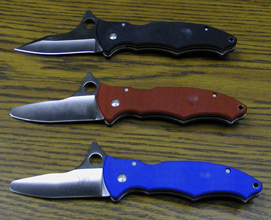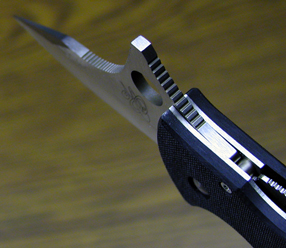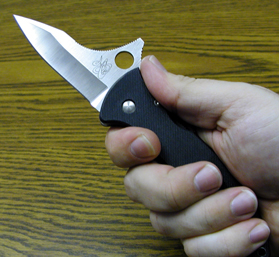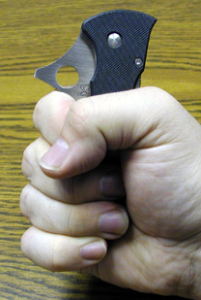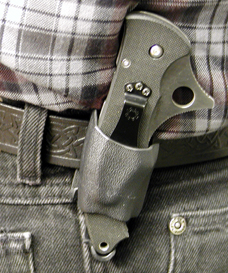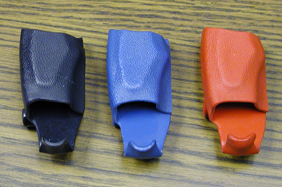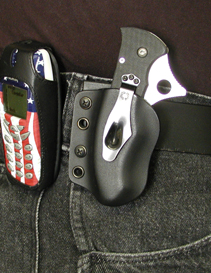Modern Arnis practitioner Bram Frank, the man behind the Gunting system of tools, is well-known in Filipino Martial Arts (FMA) circles. Equally well known is the Gunting system. Those with background in FMA will recognize the term gunting as "scissor," a technique that involves (for example) "destroying" a limb by striking it from two directions simultaneously.
The Gunting knife, designed to be both blade and impact tool, is well-suited to such applications and to a variety of striking and pressure techniques. The knife has a black handle and is accompanied by color-coded siblings: red for the Gunting Drone (a training tool designed for safe practice) and blue for the CRMIPT (a "close range medium impact tool" intended for law enforcement). The latter two do not have sharp blades. The CRMIPT is intended for use as an impact and compliance tool.
Manufactured by the prominent Spyderco, the Gunting knife and its counterparts are well made and exhibit first-rate attention to fit and finish. The knife has a subdued black pocket clip, while the other tools have silver clips. Each is equipped with Spyderco’s "compression lock," which is almost a liner lock in reverse. It is accessible from the "spine" area of the knife near the blade tang. It took me a little while to adapt to the compression lock, with which I managed to pinch my finger painfully at least once.
Apart from needing to tighten the pivot on my Gunting knife, I had no problems with any of the three Gunting tools. The knife was, as is usual for Spyderco, "scary sharp" out of the box. Releasing the compression lock, I quickly found, will cause the blade to fall free with gravity, which could catch the fingers of the unwary. Keep this in mind when opening and closing the Gunting. I found the lock itself to be quite secure in use.
The basic concept of the Gunting is of a knife that is suited to less-than-lethal applications as well as to cutting and thrusting. This is made possible by the "horns" built into the handle (which facilitate certain traps, holds, and pain compliance techniques) and by the prominent Gunting ramp — the feature that makes it most recognizable. When closed, the knife can be used for several different techniques, most notably strikes and pocket-stick-like compliance and defense moves using the top of the ramp to concentrate the force of your strikes.
ONE CAVEAT
The Gunting system is not without controversy. Some critics point out that if you do cut someone with a knife that has the "less than lethal" option the Gunting implies, you might find yourself legally liable for failing to use that lesser degree of force. Other disputes seem to revolve around the types of personal and political arguments that invariably erupt over the Internet. Still others concern whether the Gunting curriculum is practical. Each person must decide what he or she believes regarding the system and its merits, weighing the benefits of the system and of the Gunting as a tool versus the potential liabilities.
GUNTING: AN INSTRUCTOR’S VIEW
The three volume Gunting: An Instructor’s View video series is ostensibly meant to give those who teach the use of the tool more insight into just that. I have not previously watched any instructional material on the Gunting system, but I nonetheless found the tapes adequate introduction for anyone curious about the the tools and their uses.
The sound is audible and the picture quality just fine. Filmed against a stark white background, the videos feature lots of slow-motion repetitions of movements demonstrated, with changing camera angles as required. (There are times when the camera angles are a little unusual, I think just to give the tapes more visual interest.) There are even picture-in-picture close-ups of some segments of the action, which is a very nice touch.
Through it all, Bram is remarkably soft-spoken and affable as he walks the viewer through the use of the tool he designed. While I’ve "talked" with Bram via AOL Instant Messenger and through e-mail, I’d never before heard him speak until I watched these videos. Interestingly, he sounded almost exactly as I pictured him — calm and confident in the tool whose use he espouses.
VOLUME ONE
The video begins with the warning never to train using a live blade. (All Gunting training should be done with appropriate training blades or the Drone itself.) Bram introduces the Gunting system and explains the differences between the color-coded tools:
- The Drone is red and has no sharp edges. Its
"blade" is completely unsharpened. - The CRMIPT is blue and has
the Drone’s unsharpened blade. It has
sharp "horns" that are part of the handle. - The "live" Gunting is black. It has sharp
handle horns and an incredibly sharp blade.
Bram explains that the Gunting system uses "gross motor skills," movements that should be simple yet effective under stress. He goes on to explain the basic open-to-closed horizontal-vertical scissors movement of the arms that is the foundation for the use of the Gunting. He goes on to demonstrate several variations of this horizontal-vertical idea — a conceptual motion that is central to the Gunting curriculum. As you would expect from FMA, there is much checking and passing as Bram and his training partner flow through the exercise.
Depending on your skill level, what Bram considers "gross motor skills" may not appear to be so to you. This is something only the individual student can judge, particularly when considering performance under stress. Veteran FMA practitioners swear by the sometimes complex movements of their systems, whereas critics are quick to deride anything not comprised of the most rudimentary mechanics.
Bram pauses to review the material covered periodically, which is essential in an instructional video. When he moves on it is to demonstrate the impact caused by the closed Drone to show the power of the implement. He strikes a variety of pressure points on his partner, such as the inside of the arm, the shoulder, the collarbone, and the side of the neck. He also demonstrates some arm lock takedowns. As a pressure stick the Gunting’s utility (or, perhaps more specifically, the utility of its ramp) is obvious.
"The tool is important," Bram explains. "The tool is making the difference." He repeats this idea often, urging students to take the advantage offered by the Gunting.
Demonstrations of the horizontal-vertical conceptual motion continue, this time from the inside of the opponent’s arm. (It was demonstrated from the outside previously.) Bram then discusses the parts of the tool: the upper horns, upper ramp, lower horns, and lower ramp, with picture-in-picture close-up as he speaks.
In the next segment, Bram demonstrates how to practice feeling for grabs with the ramp. This again will seem complicated to some, but others will readily take to it. Numerous slow-motion demonstrations of various locks follow before Bram discusses variations on attacks from the opposite side (the opponent’s left, if he was attacking with his right to this point).
Volume One concludes with Bram’s exhortation to practice and with some more slow-motion locks and grabs with the Gunting.
VOLUME TWO
Bram begins Volume Two by showing some follow-ups to the initial horizontal-vertical motion. This includes thumb grabs, rotations, and armbars. He moves on to basic releases from grabs, explaining that the Drone gives you a distinct advantage.
In what looks very similar to Aikido or Ju Jitsu, Bram uses the Gunting to facilitate a variety of locks and joint manipulations. He also shows escapes from chokes by poking and pushing with the ramp.
In the next segment, Bram walks the viewer through a basic FMA drill, the intent of which is to give the student a feel for horizontal-vertical. It involves just what you would expect from an FMA drill — striking, checking, picking up, clearing/checking, and striking again. The drill will teach the student how to open and close his body as he comes in. This is followed by footage of Bram and his training partner engaged in an empty hand Hubud drill.
Working the horizontal-vertical movement on the low line, rather than the high line, Bram strikes his opponent’s leg after slapping aside the attack. He takes the opponent’s balance in the process.
Another picture-in-picture close-up accompanies Bram’s discussion of the Gunting’s "spoon clip," the wide pocket clip that is intended to be used as an indexing point. You can spin the knife using this index, Bram explains, showing the viewer how to spin the knife into a reverse grip to do horizontal-vertical after his initial scissor strike. More examples follow and there is slow-motion footage of the transition.
The topic of "changing grips in a knife fight" will raise no eyebrows for some readers, but others will detest the idea. Again, your skill level and your comfort with risk will determine your personal preference and opinion on the matter.
Another feature of the Gunting that is often discussed is using its ramp to perform a "kinetic opening." This is a maneuver in which the ramp is slapped and moved past on some part of an opponent’s body in order to open the blade. Bram cautions that while this can be done on an opponent without cutting that person, you cannot safely perform a kinetic opening on your own leg. You will cut yourself if you try.
Bram then demonstrates a horizontal-open-vertical movement (the "open" means the knife is locked open) on both sides and performs various holds and applications using the ramp side of the open blade. He reminds the viewer that these must never be practiced with a live Gunting.
VOLUME THREE
My copy of Volume Three actually proclaims itself "Volume 2" as it opens, a typographical error that made me recheck the box before I realized that was all it was. In Volume Three, Bram walks the viewer through open-blade drills with the Gunting folder. He goes so far as to say even a knife with the edge ground off is not safe (and certainly a taped live blade won’t do). You must use the Drone or a proper aluminum trainer.
Bram demonstrates a dexterity drill whose purpose is to teach the student to learn to move the tool. It’s not intended as a real-life application. He hits, spins the knife, cuts through, hooks, spins back, and goes on like that, flowing through the exercise. There is a picture-in-picture close-up of his footwork, too, which is a nice touch.
A flow drill that teaches targeting and moving from "open" to "closed" with the body comes next. Performed with an open drone, Bram uses striking angles from Remy Presas’ Modern Arnis. Specifically, he uses angles 1 through 5 (5 being a straight thrust) and 12 (an overhand strike).
Flowing through the six cutting angles, Bram shows the viewer how to respond to each of them as they come in. He also demonstrates empty hand responses to the same attacks, integrating his body movement. Slow-motion footage of the angles follows, as well as several sequences showing the flow drill being performed without commentary.
Demonstrating a counter-for-counter drill, Bram talks about "responsible cutting." He breaks it down into several moves, including cutting, checking, and countering the incoming cut. The drill is done on
different lines, too.
In an interesting look at dealing with a knife-wielding attacker while armed with a Gunting, Bram attacks his training partner with an open blade. The partner, in turn, responds with a closed Gunting, which comes open as he draws and counters. This is followed by a brief look at using the compression lock to drop the blade closed in order to return the open "live" Gunting to its "impact tool" mode, with more of the picture-in-picture close-ups that I now associate with this series.
SHEATHS
The Gunting is a large folding knife that really demands a belt sheath to meet its full potential. While the pocket clip is an important part of the knife, given the indexing point it provides, I would not choose to carry the knife in my pocket. This is obvious to most and belt sheaths for the Gunting are readily available.
The official color-coded sheaths for the Gunting are made by Skunkworks of Kydex. A single piece of material that incorporates a well-designed belt clip, these are simple, light, and inexpensive. They leave as much of the knife exposed as possible.
The only real drawback to the Skunkworks sheaths is the fact that they can and will shift slightly on your waistline, depending on the width of your belt. If you want a sheath that covers (and therefore protects) more of the knife and are not worried that this will hamper your draw of the Gunting, Bob at Survival Sheath manufactures a Tek-Lok-equipped clamshell model. It positions the knife farther from the body, which is either good or bad depending on your needs and preferences.
TYING IT TOGETHER
As someone who has always been drawn to FMA and who now cannot stop playing with his Gunting drone, I’d have to say I think these knives and their accompanying tapes are at least worth a look. You may decide that the system isn’t worthwhile to you, or that it is too complicated to be practical, or you may decide that you think you have the ability and the patience to make the Gunting (and its system) part of what you do.
The choice is yours.
